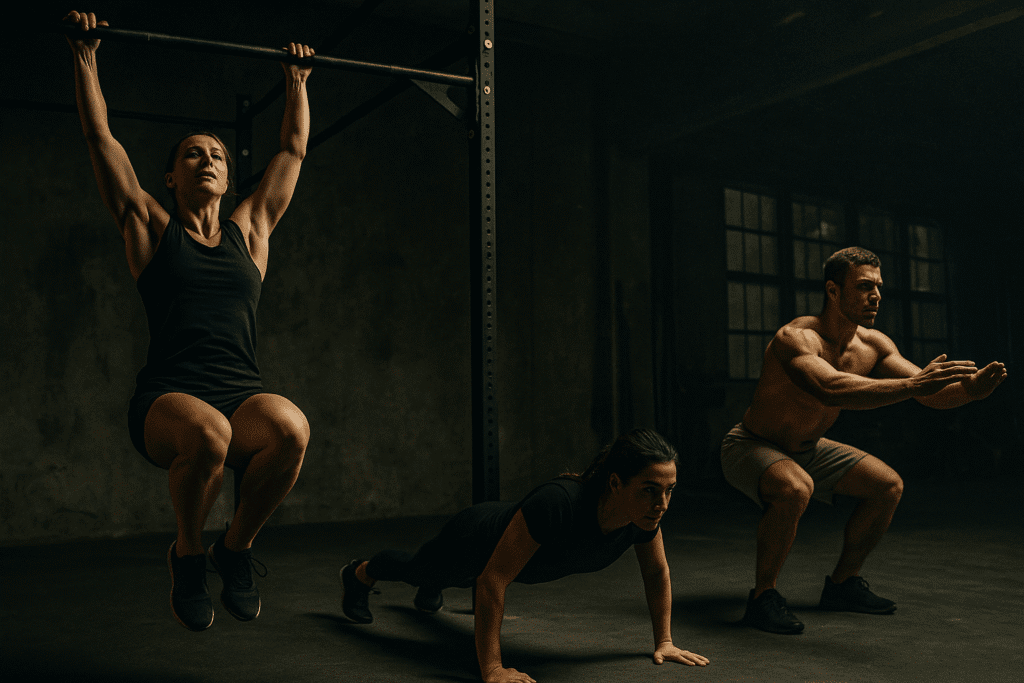What is Physical Fitness?
Physical fitness refers to the overall capability of your body to carry out everyday activities efficiently, sustain health, and fend off illness. It is based on five key components: cardiovascular endurance, muscular strength, muscular endurance, flexibility, and body composition. Regular engagement in physical activity also offers mental health advantages, including boosting mood, alleviating stress and anxiety, enhancing cognitive function, improving sleep quality, and enriching overall life satisfaction.
Research backed guidelines suggest that adults strive for 150 minutes of moderate or 75 minutes of vigorous cardiovascular exercise each week, in addition to two sessions of strength training and regular flexibility exercises. Even simple activities such as walking, gardening, or climbing stairs can significantly improve heart health, mood, energy levels, and longevity.
What is CrossFit Training?
CrossFit training is an intense fitness program that combines weightlifting, cardio training, and bodyweight workouts. Its purpose is to enhance overall fitness by focusing on physical abilities like strength, endurance, flexibility, and agility. A major advantage of CrossFit training is that its workouts can be modified to fit any fitness level, which makes it perfect for newcomers.

CrossFit Training Benefits
To Strengthen the Body
CrossFit training focuses on multi-joint squats, deadlifts, presses, and Olympic lifts. These movements promote muscle growth, enhance lean mass, and fortify bones, contributing to long-term health and vitality.
Improve Heart Health
CrossFit training improves endurance, boosts VO₂ max, and strengthens heart and lung capacity, enhancing stamina for exercise and everyday activities.
Calorie Burn & Fat Loss
Exercise stimulates calorie burning both during and after the workout. CrossFit training is a powerful method for enhancing body composition.
Improve Agility, Balance & Mobility
CrossFit training enhances coordination, flexibility, and mobility by incorporating a variety of functional exercises, crucial for everyday movement. It also improves posture and reduces the risk of injury.
Mental Toughness & Stress Relief
CrossFit training athletes also mention experiencing lower stress levels, reduced anxiety, and improved moods due to endorphins and mental discipline.
Injury Prevention & Safer Movement
CrossFit training fosters strong joints and minimises injury risk by focusing on correct mechanics, mobility, and strength. Research indicates that injury rates are comparable to or even lower than those in other high intensity sports when proper coaching is provided. shape.com.
Bone Density and Ageing Health
Weight bearing resistance workouts that are part of CrossFit training enhance bone strength, which is beneficial in preventing osteoporosis as we grow older.
Holistic Personal Growth
CrossFit training offers a well defined framework and benchmarks for establishing goals, monitoring progress, enhancing skills, and maintaining high motivation. Engagement in CrossFit training fosters discipline, consistency, and ongoing personal growth.
Improve Cognition
Research indicates that just one vigorous workout can enhance memory and focus, and CrossFit training’s organised setting promotes better eating habits and lifestyle modifications.
To increase strength and endurance
A standard CrossFit training session typically lasts about an hour and is divided into four main phases:
- warm up (to prepare the muscles and boost blood circulation)
- skill or strength training (focusing on technique or heavy lifting)
- the WOD (Workout of the Day) itself, which lasts between 5 to 30 minutes and involves a high-intensity mix of movements,
- cooldown/mobility exercises to support recovery.
The key feature is the variety of each workout, which helps avoid physical plateaus and encourages the body to adapt to new challenges.
How to Increase Strength and Endurance?
To enhance both aspects at the same time, concentrate on integrating targeted resistance training with cardiovascular workouts. Begin with compound, multi-joint exercises like squats, deadlifts, and presses utilising heavy weights for low repetitions (2–6 reps at approximately 80–90% of your one-rep max), ideally executed 2–3 times a week with extended rest periods between sets to optimise strength improvements.
Add steady state cardio sessions (30–60 minutes of moderate-intensity running or cycling) and high intensity interval training (HIIT) protocols such as 30 seconds of maximum effort followed by 15 seconds of rest for 20–30 minutes to boost your aerobic capacity and stamina.
Circuit workouts that alternate between strength and cardio exercises with minimal rest, like combining squats or push-ups with burpees or jumping rope, provide a strong stimulus for both strength and endurance. To make progress, it’s essential to implement progressive overload, gradually increasing weight, repetitions, or decreasing rest time and following a structured periodisation plan, switching focus between strength and endurance every few weeks.
Norms of CrossFit Training
Coaches are equipped to evaluate and adapt quickly, analysing skill levels, fatigue, and technique during warm ups and workouts of the day (WODs), then offering immediate scaling or feedback to enhance safety and effectiveness. Scaling is standardised across different boxes, seasoned coaches frequently demonstrate it, and training programs implement “zones” or tiers to ensure athletes consistently train at the right level.
Movement standards are explicitly outlined, be it overhead lunges or pull-ups, allowing athletes to grasp what constitutes a valid repetition. Coaches uphold these standards during WODs to ensure consistency and fairness.
CrossFit Training Exercises for Beginners
Here are some beginner-friendly CrossFit training workouts and guidance to help you kick off on the right foot:
Cindy (20-Minute AMRAP)

Workout Format
As Many Rounds As Possible (AMRAP) in 20 minutes.
Movements
- 5 Pull-Ups (Scale: ring rows or band-assisted pull-ups)
- 10 Push-Ups (Scale: knee push-ups if needed)
- 15 Air Squats
Goal
Complete as many full rounds as possible in 20 minutes. This benchmark CrossFit WOD tests muscular endurance, aerobic capacity, and mental toughness using only bodyweight movements. It is a perfect starting point for newcomers.
Body Weight Gone Bad (3 Rounds)
Workout Format
3 Rounds — 1 Minute at Each Movement
No rest between exercises, 1-minute rest after each round
Movements (1 minute each)
- Air Squats
- Push-Ups
- Sit-Ups
- Burpees
How It Works
- Perform each movement for 1 full minute, going for maximum reps.
- Move directly to the next exercise without rest.
- After completing all 4 exercises (1 round), rest for 1 minute.
- Repeat for a total of 3 rounds.
Goal
Accumulate as many total reps as possible across all rounds. This bodyweight WOD challenges full body endurance, core strength, and mental grit all with no equipment.
Death by Burpees

Workout Format
Every Minute on the Minute (EMOM) – Add one burpee each minute.
How It Works:
- Minute 1: Do 1 burpee
- Minute 2: Do 2 burpees
- Minute 3: Do 3 burpees
- Continue adding 1 burpee every minute
- Stop when you can’t complete the required burpees within the minute
Goal
Go as far as you can. This workout is both a mental and physical test, pushing your endurance, pacing, and willpower.
Tips
- Start steady and conserve energy early.
- Focus on smooth, efficient movement.
- Use the remaining time each minute to recover before the next set.
This deceptively simple WOD builds intensity fast and is a favorite benchmark for testing overall conditioning.
Dietary importance in CrossFit Training
Enhance your training with the right nutrition aim for 1.6–2.0 g of protein per kg of body weight each day and ensure you have enough carbohydrates for energy. Also, focus on recovery techniques such as mobility exercises, staying hydrated, getting 7–9 hours of sleep, and incorporating active rest days to facilitate adaptation. You will develop lasting power and stamina over time by including heavy strength training days, endurance workouts, circuit training, and consistent recovery in a structured plan.
Organic Foods
Cross Fit training’s official guidelines promote consuming unprocessed, nutrient rich foods such as meats, vegetables, nuts, seeds, certain fruits, limited starch, and strictly no added sugars. Numerous trainers embrace this “whole foods” approach, emphasising meal preparation and regular grocery shopping habits, prioritising organic, real food ingredients.

Balance Diet
Well balanced meals before and after workouts, combining carbohydrates and protein to optimise performance and recovery. Consistent meal timing and portion management are crucial for sustaining energy levels and boosting metabolism. Research indicates that CrossFit training enthusiasts typically strive for a well rounded macronutrient distribution:
Protein: about 30% of daily caloric intake, usually ranging from 1.4 to 2.2 g/kg of body weight, according to reddit.com.
Fats: approximately 30% of total calories, ideally sourced from mono- and polyunsaturated fats such as fish, nuts, and olive oil.
Carbohydrates: making up the remaining 40%-60%, adjusted according to training needs higher intake on intense training days to enhance performance.
Water intake: Proper hydration and electrolyte balance are vital, particularly during high intensity workouts.
Supplementation Practices
Many trainers recommend effective supplements: protein powders (over 50%), creatine (around 23%), pre-workout energy boosters (approximately 21%), BCAAs, omega-3 fatty acids, and recovery oriented products like tart cherry juice. Hydration is often tracked by observing urine.
Conclusion
CrossFit training is recognised as a well-rounded fitness program merging functional, full body workouts with cardiovascular training and guided recovery to enhance true physical readiness for daily activities. Its diverse WODs featuring squats, presses, pull-ups, deadlifts, sprints, and plyometrics build strength, endurance, agility, mobility, balance, and power in just 45–60 minutes per session. In addition to physical improvements, CrossFit training promotes mental toughness and stress relief through controlled intensity and community support while offering time efficient workouts ideal for busy individuals.
FAQ’s
What sets CrossFit training apart from traditional gym workouts?
Crossfit training combines various fitness disciplines, such as weightlifting, cardio, and gymnastics, into brief, diverse workouts of the day (WODs) that are organised as AMRAP (as many reps/rounds as possible), EMOM (every minute on the minute), or timed sessions. This approach, along with group coaching and a supportive community, fosters quick results, accountability, and motivation.
How frequently should beginners engage in CrossFit training?
New participants should begin with 2 to 3 weekly sessions to establish foundational skills and facilitate recovery. As their fitness levels improve, they can slowly increase the number of sessions. Modifying workouts and paying attention to one’s body is important to minimise the risk of injury and promote steady progress.
Is CrossFit training safe, particularly for those just starting?
Yes, CrossFit training can indeed be safe for beginners. The injury rates (approximately 3.2 per 1,000 hours) are similar to or even lower than those in other sports, such as strength training and running. Coaches emphasise safety by instructing on the basics, encouraging scaling, monitoring fatigue, and ensuring correct form through warm-up and cooldown sessions.

 Medically reviewed by
Medically reviewed by